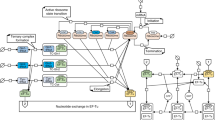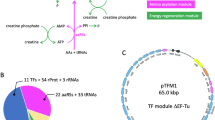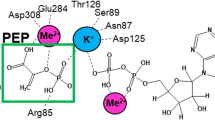Abstract
IN this laboratory, previous investigations of the transfer of amino-acids from aminoacyl sRNA to polypeptides on ribosomes (the aminoacyl transfer reaction) were carried out with cell fractions prepared from rat liver with buffered solutions containing potassium1–3. The aminoacyl transfer reaction was dependent on the concentration of potassium ion in the incubation, and optimal incorporation was obtained when the concentration of potassium in the reaction mixture was between 0.075 and 0.1 M. Recent studies with preparations of Escherichia coli have shown that ammonium ions are more effective than potassium ions and that rubidium, caesium, sodium and lithium ions are much less active in promoting aminoacyl transfer4,5. Because similar results have been obtained with the rat liver system, solutions containing ammonium are at present being routinely used in this laboratory6. This communication presents a detailed investigation of the effective concentrations of various monovalent cations on polypeptide biosynthesis. The results reveal an interesting relationship between the relative biological activity of these ions and some of their physical and chemical thermodynamic properties.
This is a preview of subscription content, access via your institution
Access options
Subscribe to this journal
Receive 51 print issues and online access
$199.00 per year
only $3.90 per issue
Buy this article
- Purchase on Springer Link
- Instant access to full article PDF
Prices may be subject to local taxes which are calculated during checkout
Similar content being viewed by others
References
Fessenden, J. M., and Moldave, K., J. Biol. Chem., 238, 1479 (1963).
Slapikoff, S., Fessenden, J. M., and Moldave, K., J. Biol. Chem., 238, 3670 (1963).
Moldave, K., Adv. Chem., 44, 41 (1964).
Lubin, M., Biochim. Biophys. Acta, 72, 345 (1963).
Conway, T. W., Proc. U.S. Nat. Acad. Sci., 51, 1216 (1964).
Gasior, E., and Moldave, K., J. Biol. Chem., 240, 3346 (1965).
Kachmar, J. F., and Boyer, P. D., J. Biol. Chem., 200, 669 (1953).
Vazquez, D., Biochem. Biophys. Res. Commun., 15, 464 (1964).
Spyrides, G. J., Proc. U.S. Nat. Acad. Sci., 51, 1220 (1964).
Author information
Authors and Affiliations
Rights and permissions
About this article
Cite this article
LEVINE, H., TRINDLE, M. & MOLDAVE, K. Monovalent Cation Requirement for the Aminoacyl Transfer Reaction in Protein Synthesis. Nature 211, 1302–1303 (1966). https://doi.org/10.1038/2111302a0
Issue Date:
DOI: https://doi.org/10.1038/2111302a0
This article is cited by
-
Zeolite-mediated cation exchange enhances the stability of mRNA during cell-free protein synthesis
Biotechnology and Bioprocess Engineering (2006)
-
Zur Alkali-Ionenwirkung auf Teilreaktionen der ribosomalen Peptidsynthese
Die Naturwissenschaften (1967)
Comments
By submitting a comment you agree to abide by our Terms and Community Guidelines. If you find something abusive or that does not comply with our terms or guidelines please flag it as inappropriate.



